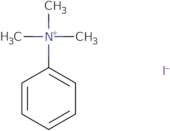Trimethylphenylammonium iodide
CAS : 98-04-4
Ref. 3D-FT28552
| 1g | Arrêté | ||
| 2g | Arrêté | ||
| 5g | Arrêté | ||
| 10g | Arrêté | ||
| 500mg | Arrêté |
Informations sur le produit
- Trimethylanilinium iodidePhenyltrimethylammonium iodideN,N,N-Trimethylanilinium iodide
- Ammonium, trimethylphenyl-, iodide
- Benzenaminium, N,N,N-trimethyl-, iodide
- Benzenaminium, N,N,N-trimethyl-, iodide (1:1)
- N,N,N-Trimethyl-Benzenaminiuiodide
- N,N,N-Trimethylaniline iodide
- N,N,N-Trimethylanilinium iodide~Trimethyl phenylammonium iodide
- N,N,N-Trimethylaniliniumiodide
- N,N,N-Trimethylbenzenaminiumiodide
- N,N,N-trimethylanilinium iodide
- Voir d'autres synonymes
- N,N-Dimethylaniline methiodide
- N,N-Dimethylanilinemethiodide
- Phenyl Trimethyl Ammonium Iodide
- Phenyltrimethyl-Ammoniuiodide
- Phenyltrimethylammonium Iodide 99%
- Phenyltrimethylammoniumiodide,99%
- Trimethylanilinium iodide
- Trimethylanilliniumiodide
- Trimethylphenyl-Ammoniuiodide
- Phenyltrimethylammonium iodide
Trimethylphenylammonium iodide is a pyrimidine compound that interferes with the replication of DNA by binding to the hydroxyl group in the pyrimidine ring. It has been shown to inhibit monoamine oxidase and acetylcholine esterase, which are enzymes responsible for the breakdown of neurotransmitters. Trimethylphenylammonium iodide has also been shown to have transport properties in model solutions. This chemical reacts with acetylcholine and hydrogen bonds to form an unstable complex, which is then hydrolyzed by water. Trimethylphenylammonium iodide has also been found to be active against group P2 replicating organisms such as Mycobacterium tuberculosis and Mycobacterium avium complex.





